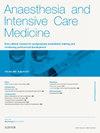Anaesthetic equipment in low- and low-to-middle-income countries
IF 0.3
Q4 ANESTHESIOLOGY
引用次数: 0
Abstract
There is a discrepancy between healthcare need and the ability to provide safe anaesthesia in low- and low-to-middle-income countries (LMICs). There is a shortage of medically trained anaesthetists. Most anaesthetics are provided by non-physician anaesthetists who may not have studied the core sciences underpinning anaesthesia, but are clinically very competent. Poor infrastructure is common, such as a shortage of piped medical gases and critical care beds. Safe anaesthesia depends on effective technology, and on consumables such as cannulae, and drugs, all of which are under-provided resources in LMICs. Much of the equipment used in the developed world is unsuitable for use in LMICs. Anaesthetic equipment used in LMICs, such as draw-over breathing systems and oxygen concentrators, may be unfamiliar to developed world anaesthetists. Cleaning and maintenance of equipment is usually the responsibility of the anaesthetist, who needs a good understanding of how it works.
低收入和中低收入国家的麻醉设备
在低收入和中低收入国家,卫生保健需求与提供安全麻醉的能力之间存在差异。受过医学训练的麻醉师短缺。大多数麻醉师是由非医师麻醉师提供的,他们可能没有研究过麻醉的核心科学基础,但在临床上非常胜任。基础设施薄弱是普遍现象,例如缺少输送的医用气体和重症监护病床。安全麻醉依赖于有效的技术以及套管和药物等消耗品,而这些都是中低收入国家提供的资源不足的。发达国家使用的许多设备不适合中低收入国家使用。中低收入国家使用的麻醉设备,如抽吸式呼吸系统和氧气浓缩器,对于发达国家的麻醉师来说可能并不熟悉。清洁和维护设备通常是麻醉师的责任,他们需要很好地了解它是如何工作的。
本文章由计算机程序翻译,如有差异,请以英文原文为准。
求助全文
约1分钟内获得全文
求助全文
来源期刊

Anaesthesia and Intensive Care Medicine
ANESTHESIOLOGY-
CiteScore
0.50
自引率
0.00%
发文量
152
期刊介绍:
Anaesthesia and Intensive Care Medicine, an invaluable source of up-to-date information, with the curriculum of both the Primary and Final FRCA examinations covered over a three-year cycle. Published monthly this ever-updating text book will be an invaluable source for both trainee and experienced anaesthetists. The enthusiastic editorial board, under the guidance of two eminent and experienced series editors, ensures Anaesthesia and Intensive Care Medicine covers all the key topics in a comprehensive and authoritative manner. Articles now include learning objectives and eash issue features MCQs, facilitating self-directed learning and enabling readers at all levels to test their knowledge. Each issue is divided between basic scientific and clinical sections. The basic science articles include anatomy, physiology, pharmacology, physics and clinical measurement, while the clinical sections cover anaesthetic agents and techniques, assessment and perioperative management. Further sections cover audit, trials, statistics, ethical and legal medicine, and the management of acute and chronic pain.
 求助内容:
求助内容: 应助结果提醒方式:
应助结果提醒方式:


